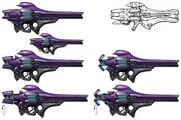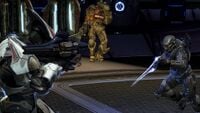Kopasa'mada-pattern plasma launcher
From Halopedia, the Halo wiki
| Kopasa'mada-pattern Firebomb Launcher | |
|---|---|

| |
| Production overview | |
|
Manufacturer: |
|
|
Type: |
Plasma-based explosives launcher |
| Specifications | |
|
Length: |
|
|
Ammunition type: |
|
|
Capacity: |
12 bolts[3] |
|
4-bolt semi-automatic burst | |
|
Optics: |
2.5× smart-link optical magnification[2][3] |
| Service history | |
|
In service: |
|
The Kopasa'mada-pattern Firebomb Launcher[3] (UNSC Type classification: Type-52 Guided Munitions Launcher/Explosive, T-52 GML/E) more commonly known as the plasma launcher, is a plasma-based explosive launcher used by the Covenant before and during the Human-Covenant War.[2][4]
Overview[edit]
Design details[edit]
The plasma launcher is a shoulder-fired heavy plasma weapon. When firing, the weapon is capable of launching up to four large explosive Class-1 guided plasma bolts at a single target - with each bolt similar to the plasma grenades standard in Covenant deployments. How many shots are fired depends on the charging time. The wielder may release the trigger at any time to fire the charged shots, and the weapon will automatically fire after 4 bolts have been ready for 3 seconds. The bolts track vehicles and bipeds similarly to the Type-33 needler, although slightly differently- a red circle will appear around a target to indicate the Launcher is "locked on". The Plasma Launcher has a 2.5× zoom capability, which enables the user to lock onto targets from farther away. The bolts will continue to track until they hit the target or another object, regardless of the death of the operator, being redirected by physical impulses or the target teleporting across vast distances.[2][4]
Usage[edit]
Plasma launchers, in concept, have been in Sangheili service since the War of Beginnings era - with the Xellus clan employing them in 850 BCE.[5] The Koposa'mada-pattern entered service in the Covenant several centuries prior to the Human-Covenant War in the 26th century, and remained a staple of Sangheili warriors and armoured detachments right up until the war's end in 2552.[3][4]
In-game information[edit]
Halo: Reach[edit]
- Main article: Plasma Launcher (gameplay)
The bolts stick to the target on impact, like plasma grenades. The detonation time is dependent on the amount of bolts stuck to the target, which means that single shots often give kills from the grave. The bolts have an arcing trajectory when fired untracked over long distances. It has an appearance slightly similar to the Fuel Rod Gun, as they are both Covenant heavy weapons, though the Launcher is blue and the Fuel Rod Gun is brown/gold.[6][7] The Plasma Launcher is carried in combat by high-ranking Grunts, Elites, and Brutes.
Trivia[edit]
- The sound file for the plasma launcher was first released in the Bungie Weekly Update 1/29/10, with the title "Mystery Weapon", though it sounds subtly different in the final build of the game.[8]
- When Warzone Firefight was made available in Halo 5: Guardians, the plasma launcher was included in this mode, and it can be used by the player. However, the shots are not fully rendered and there is no first-person model of the weapon. Other players can see the player holding the weapon, though.
Gallery[edit]

|
Browse more images in this article's gallery page. |
Halo: Reach[edit]
The plasma launcher being fired in the Halo: Reach Beta.
SPARTAN-B312 firing the plasma launcher at a Zurdo-pattern Wraith.
A Sangheili Ultra carrying the plasma launcher into battle.
Halo 5: Guardians[edit]
List of appearances[edit]
- Halo: Reach (First appearance)
- Halo: Broken Circle
- Halo 5: Guardians (Glitch)
- Halo: Envoy
- Halo: Empty Throne (Mentioned only)
Sources[edit]
- ^ a b Halo: The Essential Visual Guide, page 184
- ^ a b c d e Halo Waypoint, Plasma Launcher (Retrieved on Apr 27, 2012) [local archive] [external archive]
- ^ a b c d e f g Halo Encyclopedia (2022 edition), page 297
- ^ a b c Bungie.net, Halo: Reach - Ordnance Page (Retrieved on Oct 13, 2014) [archive]
- ^ Halo: Broken Circle, chapter 1
- ^ Halo: Reach, Plasma Launcher in-game weapon
- ^ Halo: Reach marketing, Halo: Reach Multiplayer Trailer
- ^ Bungie.net, Bungie Weekly Update: 01.29.10 (Retrieved on Jan 15, 2011) [archive]
| ||||||||||||||||||||
















